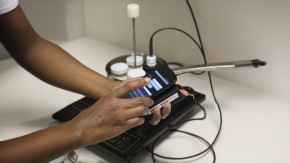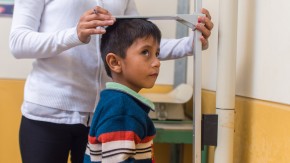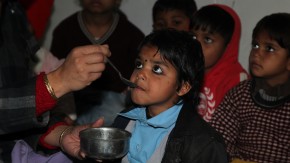
Later this month I'll be attending the Grand Challenges in London, an assembly of scientists, private-sector partners, government representatives, and other key members of the global health and development communities who are united by their desire to find solutions to the biggest challenges facing people in the developing world. The premise of the Grand Challenges is simple: Anyone, from any sector, can apply for a grant if they have an innovative idea that could lead to breakthrough advances to complex challenges.
Investing in this type of early-stage research is incredibly important to driving long-term impact, as it ultimately increases the likelihood that the most promising new tools are developed quickly, for more people, and at lower cost. And the fight against onchocerciasis is an excellent example of an area where we've made significant headway because of this approach.
Chances are you've never heard of onchocerciasis. Sometimes it's known by the nickname "river blindness," but you've probably never heard of that, either. Unfortunately, almost 40 million people suffer from it. Onchocerciasis is one of a number of diseases that get so little attention, global health experts have put them together in a category they call Neglected Tropical Diseases (NTDs). That "neglected" means a lot of different things, one of which is that not many scientists are doing innovative research to combat these illnesses. One thing I really like about my job, though, is that I get to work with some of the exceptions. One of them is Dr. Joseph Turner, and he's innovating to find a cure for onchocerciasis.
River blindness is a skin and eye infection that can cause rashes, blindness, and itching so awful it can lead infected people to pour boiling water on themselves to make it stop. The disease, which is caused by a worm transmitted by flies that live near rivers, can be controlled with treatments of ivermectin. But this is where the "neglected" aspect of NTDs becomes an issue, because ivermectin is a problematic drug. To start with, it only kills young larvae, not adult worms, which live for 15 years. That means that people with river blindness have to get treated again and again, both to prevent new worms from spreading the infection and to reduce symptoms from the worms that are already in their bodies. There have also been recent signs that the worm is developing resistance to ivermectin. Worst of all, in regions where river blindness is common, 20 percent of people who suffer from it are also infected with Loa loa, another NTD; these people often have a severe reaction to ivermectin that can cause brain damage and even death. For a more widely known disease like cancer, a drug profile like that - one you have to take for years, that's losing effectiveness, and that you can't use for almost a fifth of people who have the disease - would have sent a whole lot of scientists to the lab long ago.
That's not to say that nobody has been researching river blindness. But there are serious challenges facing this research. In most cases, we develop medicines by testing them first in laboratory animals like mice and guinea pigs and only then in humans. But in the case of onchocerciasis, the mouse immune system kills the worm very, very quickly. In fact, pretty much every animal kills the worm - except that there's a close relative of the worm that lives in cows. So theoretically, river blindness researchers could use cows as their "animal models," but cows' bodies are so different from ours that they can't tell us much about how drugs will work on people. Plus, they weigh half a ton each, so filling a lab with them would present an interesting logistical challenge!
This is where Dr. Turner comes in. After he went to Cameroon to do his doctoral research, he started working on a cure for river blindness at the Liverpool School of Tropical Medicine (LSTM). But he was stymied by the problem that there were no animals appropriate for testing - until finally he decided to make one. Rather than build a better mousetrap, he built a better mouse.
With the help of Grand Challenges Explorations, and in collaboration with his LSTM colleague Professor Mark Taylor and Professor Samuel Wanji of Cameroon's University of Buea, he set up a lab in Cameroon and began looking for genetically modified mice whose immune systems were impaired in ways that made them susceptible hosts of onchocerciasis. Dr. Turner's team found several appropriate mice and crossed them together to make new "compound" knockout mice that were super-susceptible.
Then they started the process of investigating drugs. First they collected worms: Every morning they went to the local slaughterhouse, where about one in 20 of the cows that came in would have the bumps on their hides that were signs of cow onchocerciasis. Once those cows were slaughtered, the team brought their hides back to the lab, where they extracted the worms and injected them into the mice, which, because of the genetic modifications, stayed infected, just like humans. Then they started testing chemical compounds to measure how well they targeted the infection.
They've tested a lot of compounds since they started work in 2013, and so far they've found three promising candidates for further clinical testing. Dr. Turner and his co-investigators will test several more compounds, which are being provided by an international consortium of academic and pharmaceutical partners. Then they have to make sure that the compounds that work are also safe in the presence of Loa loa - which they'll do by testing them on another new mouse model they've created to be particularly vulnerable to Loa loa. All in all, they expect to provide the onchocerciasis drug research community with information to make a decision about which compounds to select for human trials by the end of next year.
The infectious diseases that get a lot of attention absolutely deserve that attention, and I'm glad so many scientists are working to fight them. But I'm also glad that Joseph Turner, Mark Taylor, and Samuel Wanji are focusing on river blindness. Because of their innovations and the innovations of others like them, onchocerciasis may someday be a disease that's neglected for no other reason than that it's no longer a significant problem.



